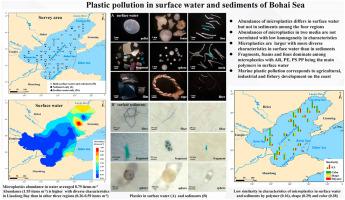Environmental Pollution ( IF 7.6 ) Pub Date : 2021-03-04 , DOI: 10.1016/j.envpol.2021.116874 Lili Xu , Liang Cao , Wei Huang , Jinhu Liu , Shuozeng Dou

|
Plastics are globally distributed in oceans and can pose a threat to the environment and organisms. In this study, plastic pollution in surface water and sediments of the Bohai Sea was assessed based on plastic abundance, distribution and characteristics (shape, polymer, size and color). Water and sediment samples were collected across the sea using a plankton net (330 μm) and a grab sampler, respectively. The following conclusions were reached. 1) In surface water, large plastics were less abundant (0.14 items/m3) and showed less diverse characteristics than microplastics (0.79 items/m3) but did not significantly differ in spatial distribution. 2) Microplastics in water were more abundant (1.95 items/m3) with more diverse characteristics in Liaodong Bay than in other regions of the sea (0.26-0.59 items/m3). Plastic waste from highly concentrated agricultural, industrial and fishery activities could make large contributions to microplastics in Liaodong Bay. Additionally, low hydrodynamics and long distance to Bohai Strait are unfavorable for diffusion of particles, facilitating the retention of microplastics and increasing the abundance in this bay. 3) Microplastics in sediments were smaller in terms of dominant sizes (<0.5 mm) with less diverse characteristics than particles in water (0.5-1.5 mm). Specifically, fragments, foams and lines dominated among the microplastics in water, whereas fibers and fragments were dominant particles in sediments; alkyd resin, polyethylene, polystyrene and polypropylene (PP) predominated among the particles in water, but rayon, cellulose and PP were dominant particles in sediments. 4) Neither abundance nor size of microplastics in the two media was proportionally correlated and showed low similarity indexes of polymer (0.16), shape (0.29) or color (0.38). This could be related to mismatch in spatiotemporal distributions and variations in the characteristics, fate and behavior of microplastics in the two media. The findings provide knowledge for tracing the sources of plastics in the Bohai Sea.
中文翻译:

渤海塑料污染评估:丰度,分布,形态特征和化学成分
塑料在全球范围内分布在海洋中,可能对环境和生物构成威胁。在这项研究中,根据塑料的丰度,分布和特征(形状,聚合物,大小和颜色)评估了渤海地表水和沉积物中的塑料污染。分别使用浮游生物网(330μm)和抓斗式采样器在整个海洋中收集水和沉积物样本。得出以下结论。1)在地表水中,大型塑料的数量较少(0.14个/ m 3),比微塑料(0.79个/ m 3)表现出较少的多样性,但空间分布没有显着差异。2)水中的微量塑料含量更高(1.95个/ m 3)在辽东湾的特征比其他海域更多样化(0.26-0.59个/ m 3)。来自高度集中的农业,工业和渔业活动的塑料废物可能为辽东湾的微塑料做出巨大贡献。此外,低水动力和到渤海海峡的距离太长不利于颗粒的扩散,有利于保留微塑料并增加该海湾的丰度。3)与水中的颗粒物(0.5-1.5 mm)相比,沉积物中的微塑料的主要尺寸(<0.5 mm)较小,具有较少的特征。具体来说,碎片,泡沫和细线在水中的微塑料中占主导地位,而纤维和碎片是沉积物中的主要颗粒。醇酸树脂,聚乙烯,聚苯乙烯和聚丙烯(PP)在水中的颗粒中占主导地位,但人造丝,纤维素和PP是沉积物中的主要颗粒。4)两种介质中微塑料的丰度或尺寸均未成比例相关,并且显示出聚合物(0.16),形状(0.29)或颜色(0.38)的相似度较低。这可能与两种介质中时空分布的不匹配以及微塑料的特性,命运和行为的变化有关。这些发现为追踪渤海塑料来源提供了知识。











































 京公网安备 11010802027423号
京公网安备 11010802027423号